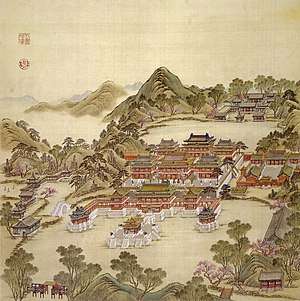Sharawadgi
Sharawadgi or sharawaggi is a style of landscape gardening or architecture in which rigid lines and symmetry are avoided to give the scene an organic, naturalistic appearance. This concept was influential in English landscape gardening in the 18th century, starting with Sir William Temple's essay Upon the gardens of Epicurus, and reports from China of the Jesuit missionary, Father Attiret. Sir William Temple first used the word sharawadgi in discussing the Chinese idea of beauty without order in garden design, in contrast to the straight lines, regularity, and symmetries then popular in European gardens.[1][2] The style indicates a certain irregularity in the design.

Sharawadgi was defined in the 1980s as an "artful irregularity in garden design and, more recently, in town planning".[3] The word inspired the coinage of the term "sharawadji effect" by composer Claude Schryer, which is used in relation to music and the listening experience.[4]
Etymology
The term sharawaggi (more frequently spelled sharawadgi) typically referred to the principle of planned naturalness of appearance in garden design. It was first used by Sir William Temple (1628–1699) in an essay, written in 1685 but published in 1692, "Upon the Gardens of Epicurus".[1][5] Temple may have picked up the term from a Dutchman who once lived in the East Indies.[6] Horace Walpole associates the term with irregularity, asymmetry, and freedom from the rigid conventions of classical design; by the time of it was used by Walpole it had become a common term in the lexicon of eighteenth-century aesthetic theory.[7][8]
However, the original word for sharawadgi has been a matter of debate. Some had attempted to reconstruct a possible Chinese origin of the word, for example, "sa luo gui qi" (洒落瑰琦) meaning "quality of being impressive or surprising through careless or unorderly grace",[9][10] another proposed san luan (散亂) or shu luo (疏落), both meaning "scattered and disorderly", in combination with wei zhi (位置, position and arrangement) to mean "space tastefully enlivened by disorder".[11] After reviewing the suggestions, however, Susi Lang and Nikolaus Pevsner concluded that the word cannot be firmly established to be a Chinese term.[10] Michael Sullivan suggested that it is a corruption of a Persian word, while a number of other scholars proposed a Japanese origin.[6][12][13] E.V. Gatenby and Ciaran Murray thought that it originated from the Japanese term sorowaji (揃わじ), which means asymmetry, irregular.[13] However, it is argued that this suggestion relies on possible meaning and similarity in sound only, without any other corroboration.[14][6] Garden scholar Wybe Kuitert proposes that it stems from the Japanese term shara'aji or share'aji (洒落味、しゃれ味), used to describe decorative motifs in works of applied art. Although there is no attested usage of shara'aji in the Edo period when the term was first borrowed into English, Kuitert argued that both its components shara and aji were important aesthetic concepts in the era, and would have been used in tandem by craftsmen of the period. Shara has a number of possible meanings relating to witty wordplay and association, its meaning extending to emblematic word games in applied arts; while aji means "taste". The term shara'aji had been used a few times in literary criticism; and is still in common use for items such as kimonos.[6]
History

Merchants from the Dutch East India Company may have brought the term to Europe at the end of the seventeenth century together with Edo period Japanese lacquer ware such as cabinets and screens that they imported from Japan.[15] Sharawadgi as a term in written discourse was introduced in England by Sir William Temple in his essay Upon the Gardens of Epicurus.[16] Temple was an English ambassador residing in The Hague and associating with the King and Queen.
He took the exotic, non-symmetric landscapes depicted on such imported artwork as supporting his personal preference for irregular landscape scenery. He had seen such irregularity in Dutch gardens where a discourse was on about naturalness in landscapes, planned or not.[17] As a result of his introducing the term sharawadgi, Temple is considered to have been among those who introduced the basic ideas that led to the development of the English landscape garden movement.[18]
Joseph Addison took up this discourse (1712), without direct reference to sharawadgi, at which time the original meaning got lost. In England the term reappears with Alexander Pope (1724) and Horace Walpole (1750), to be picked up again by Nikolaus Pevsner, who brought sharawadgi to the field of town planning.
Other meanings
- The Sharawadji Effect in music
Inspired by the original idea of more organic, naturally-led garden landscaping, the Sharawadji Effect (spelled with a j rather than a g) has been employed in music, using more natural, ambient soundscapes to create richer, more encompassing, and more realistic "soundscapes".[19] Information on the origins of the Sharawadji Effect in music is not widely accessible, but scholars seem to agree on the definition that sharawadji is "An aesthetic effect that characterizes the feeling of plenitude that is sometimes created by the contemplation of a sound motif or a complex soundscape of inexplicable beauty."[20] When the Chinese visit a garden that is beautiful because of its organic quality (in other words, its apparent lack of organized design), it is often said that its 'sharawadji' is admirable. In the same fashion, a musical piece employs the Sharawadji Effect if it has a less clean-cut, structural quality and overall a more naturally ambient sound.
- Kimono fashion
In modern Japan, share'aji is a term used in kimono fashion where it refers to the taste of the design motifs featured in kimono dress, and the coordination of the sash obi with that of the kimono, and to the occasion of wearing them.[21]
References
- Citations
- Temple, William (1908). Upon the Gardens of Epicurus, with other XVIIth century garden essays. Chatto and Windus. pp. 33–34.
- Liu, Yu (2008-01-01). Seeds of a Different Eden: Chinese Gardening Ideas and a New English Aesthetic Ideal. Univ of South Carolina Press. p. 7. ISBN 9781570037696.
- John Fleming, Hugh Honour, Nikolaus Pevsner. The Penguin Dictionary of Architecture. 1980, p. 296
- Ulvaeus, edited by David Rothenberg & Marta (2009). The Book of Music and Nature : an anthology of sounds, words, thoughts (Second edition. ed.). Middletown, Conn.: Wesleyan University Press. pp. 123–129. ISBN 9780819569356.CS1 maint: extra text: authors list (link)
- Yu Liu (2008). Seeds of a Different Eden: Chinese gardening ideas and a new English aesthetic ideal. University of South Carolina Press. p. 12. ISBN 9781570037696.
- KUITERT, Wybe (2014). "Japanese Art, Aesthetics, and a European Discourse: Unraveling Sharawadgi" (PDF). Japan Review. 27: 77–101.
- Murray, Ciaran (1998). Sharawadgi: The Romantic Return to Nature. Rowman & Littlefield. ISBN 9781573093293.
- Porter, David (1999). "From Chinese to Goth:Walpole and the Gothic Repudiation of Chinoiserie". Eighteenth-Century Life. The Johns Hopkins University Press. 23 (1): 46–58.
- Y.Z. Chang (1930). "A Note on Sharawadgi". Modern Language Notes. 45 (4): 221–224.
- Susi Lang and Nikolaus Pevsner (December 1948). "Sir William Temple and Sharawaggi". The Architectural Review. 106: 391–392.
- Qian Zhongshu (錢鍾書) (1940). "China in the English Literature of the Seventeen Century". Quarterly Bulletin of Chinese Bibliography. 1: 351–384.
- Yu Liu (2008). Seeds of a Different Eden: Chinese gardening ideas and a new English aesthetic ideal. University of South Carolina Press. p. 18. ISBN 9781570037696.
- Murray, Ciaran (1998). "Sharawadgi Resolved". Garden History. Garden History Society. 26 (2): 208–213. doi:10.2307/1587204. JSTOR 1587204.
- Ciaran Murray and Wybe Kuitert (2014). "Letters to the Editor". Journal of Garden History. 42 (1): 128–130.
- See Wybe Kuitert "Japanese Art, Aesthetics, and a European discourse – unraveling Sharawadgi" Japan Review 2014 ISSN 0915-0986 (Vol.27)
- William Temple. "Upon the Gardens of Epicurus; or Of Gardening in the Year 1685." In Miscellanea, the Second Part, in Four Essays. Simpson, 1690
- see Wybe Kuitert "Japanese Robes, Sharawadgi, and the landscape discourse of Sir William Temple and Constantijn Huygens" Garden History, 41, 2: (2013) pp. 157–176, Plates II–VI ISSN 0307-1243
- See:Geoffrey Jellicoe (ed.) The Oxford Companion to Gardens, Oxford University Press, 1986, p. 513
- Rothenburg, David (2001). The Book of Music and Nature. Middletown, CT: Wesleyan University Press. pp. 58–68. ISBN 0-8195-6407-9.
- Picard, Francois (2014). "Producing sound, hearing sound, reacting to sound : Western and Chinese reactions (1600-1780)". HAL Archives. Picard CHIME Aarhus. Retrieved 27 September 2016.
- See Wybe Kuitert "Japanese Art, Aesthetics, and a European discourse – unraveling Sharawadgi" Japan Review 2014 ISSN 0915-0986 (Vol. 27) pp. 85–86
- Sources
- Kuitert, Wybe (2014), "Japanese Art, Aesthetics, and a European discourse – unraveling Sharawadgi" (PDF), publications.nichibun.ac.jp/en/item/jare/2014-08-29/pub, Japan Review (2014) Vol. 27, pp. 77–101CS1 maint: ref=harv (link)
- Kuitert, Wybe (2013), Japanese Robes, Sharawadgi, and the landscape discourse of Sir William Temple and Constantijn Huygens, Garden History Vol. 41/2: pp. 157–176, Plates II–VICS1 maint: ref=harv (link)
- Murray, Ciaran (1998), Sharawadgi: The Romantic Return to Nature, Rowman & Littlefield, ISBN 9781573093293CS1 maint: ref=harv (link)
- Yu Liu (2008), Seeds of a Different Eden: Chinese gardening ideas and a new English aesthetic ideal, University of South Carolina Press, ISBN 9781570037696CS1 maint: ref=harv (link)
- David Porter (1999), From Chinese to Goth: Walpole and the Gothic Repudiation of Chinoiserie, Eighteenth-Century Life 23.1 (1999) 46-58, The Johns Hopkins University PressCS1 maint: ref=harv (link)
| Look up sharawadgi in Wiktionary, the free dictionary. |